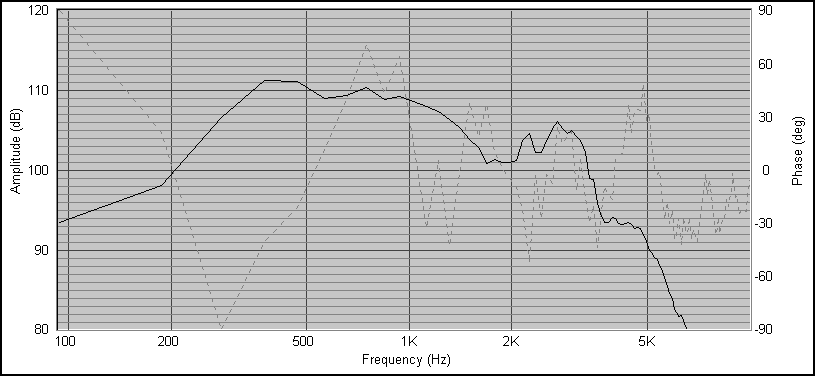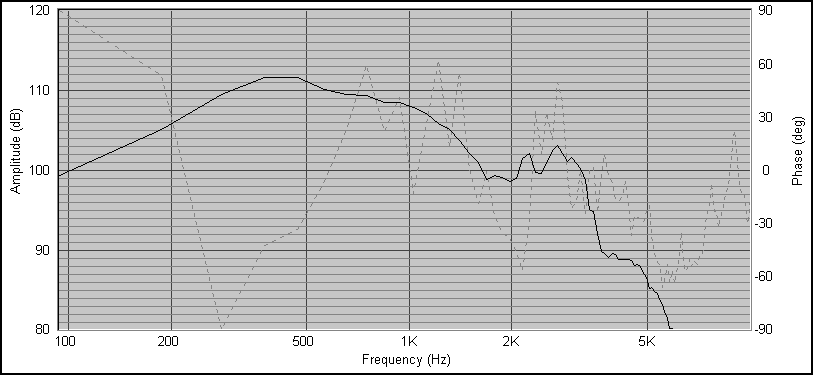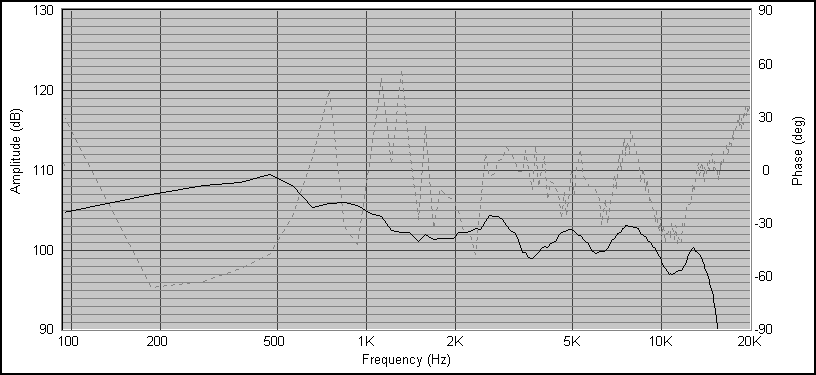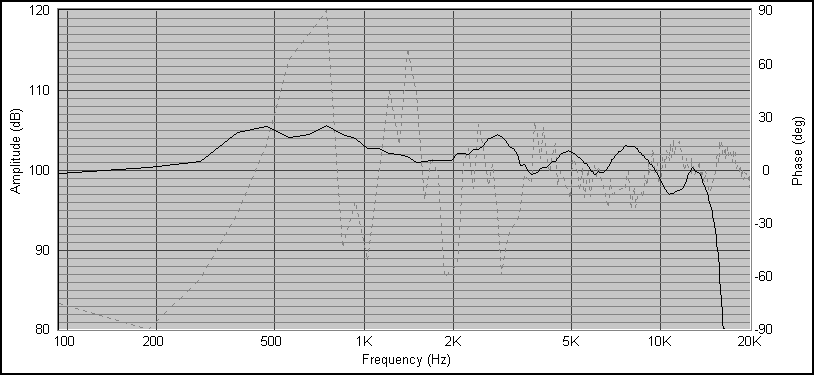

Posted by Wayne Parham [ 66.137.59.19 ] on April 12, 2004 at 02:03:31:
In Reply to: Midrange Horn posted by Wayne Parham on April 12, 2004 at 02:00:52:
The simplest implementation of the horn is as a full vocal range driver. When used in this way, it will provide output from 250Hz to 3.5kHz in free space, or 150Hz to 3.5kHz quarter-space or eighth-space, such as when used indoors. For public address or speech amplification, this is really all you need.

Response is down -3dB at 300Hz and 1.2kHz, -6dB at 250Hz and 1.6kHz and -10dB at 200Hz and 3.5kHz. In room boundaries extend low frequency performance and make the overall response curve smoother. You can expect lower rolloff points to shift an octave lower in room corners.
The intended application is to use existing 1.6kHz crossovers in many π Speakers models. As such, output above 2kHz is not wanted. So adding a 1mH coil in series shaves the 3kHz peak without doing much of anything else.

As you can see, the coil reduces the peak about 3dB, just enough to drop the overtone region a bit. It has absolutely no effect on horn output below 2kHz. The tweeter will cover the range above 1.6kHz so midrange output above 2kHz is unwanted.
Midrange horn output is as high as the compression driver, so this leaves us with a couple of configuration options. The tweeter crossover's compensation cable assembly can be removed and a shunt damper installed on the tweeter instead. A damping resistor is required to prevent the voice coil from peaking with crossover capacitance. But level matching attenuation could be removed, allowing the tweeter horn and the midrange horn to generate 105dB/W/M.
But that would leave us with a couple of problems to solve by other means. Without top-octave compensation, the tweeter will begin to rolloff at 4kHz and EQ will be required. Also, the midrange horn will rolloff around 200Hz or 300Hz, depending on its placement. So unless the woofer is capable of 105dB/W/M, it will need some EQ as well.
Leaving the tweeter compensation in place gives the following response curve:

As you would expect, tweeter response is extended but it is also shelved at a reduced level. It actually sounds pretty good this way, and some audiophiles might prefer it. But my solution is to pad the midrange to match, using a 4 ohm series resistor followed by 8 ohms in shunt.

This brings sensitivity down to 98dB/W/M, but it does offer some advantages. Obviously, the response curve is made flatter. Also, the system is well-damped by the padding resistors, and the amplifier sees a more resistive load. The amplifier is presented a load that is gradually rising through the midrange and overtone region but that is mostly resistive. It sounds very, very nice.
Now for the crossover to the woofer. The common-sense thing would be to replace the woofer crossover components, dropping the lower crossover point down to 200Hz for a cornerhorn or 300Hz for bass-reflex or freestanding horn. That's a good approach. The wavelength of 200Hz is over 5 feet, so unless the woofer and midrange are very far apart, you'll want the woofer and midrange in phase electrically. That ensures that the midrange and woofer are phased properly at the crossover point.
I connected the midhorns to an existing pair of seven π cornerhorns this way. I connected everything up as is described here, with the midrange padded down to match the tweeter, and the tweeter connected in reverse polarity. I am very pleased with this system; It sounds very good and well balanced. You gain all the benefits of reduced midrange distortion and flatter response from the front midhorn, and you maintain the room filling richness, the sort of homogenous uniformity of the reverberent field that only the cornerhorn configuration and it's uniform 90o dispersion can provide.
For any of you that might want to get started now, it's relatively easy for you to connect everything up as I did. If you want, you can swap the woofer crossover components to shift the lower crossover point down to 250Hz. Or you can order the π 250/1K6 crossover, because it's already made this way and ready to go.
[ PiSpeakers Forum ] [ Help ]